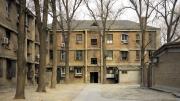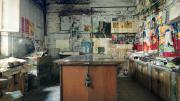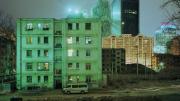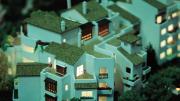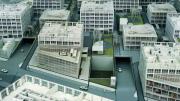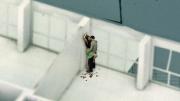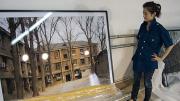Among the most disorienting features of living in contemporary China must be the pursuit, seriatim, of grand social visions to which its people have been subjected. Mao’s catastrophic enthusiasms—the backyard iron foundries of the Great Leap Forward, the war on tradition and learning during the Cultural Revolution—burned out when the society could tolerate no more starvation and forced “suicides.” But other experiments left, and are leaving, tangible evidence of the sweeping upheavals in everyday life. Seeing Utopia: Visions of Contemporary Chinese Urbanscapes, the first exhibition at the Fairbank Center for Chinese Studies, presents two documentary photographers’ records of Beijing. Their juxtaposition makes vividly clear a pace of change—in underlying ideologies, and in the social order—that outsiders can scarcely imagine.
Both Wang Di and Xing Danwen—the former little known abroad, the latter an international art celebrity—trained as painters, according to Rockefeller professor of Asian art Eugene Wang, who curated the show with graduate student Ren Wei. But their artistic trajectories differed significantly. A native of the capital city, Wang Di was immersed in the urban youth culture of the 1980s, capturing the anxieties and ironies of that era as a rock performer and filmmaker. Xing Danwen, who grew up in Xian, came to Beijing and immersed herself in the disenchanted, atomized art scene there in the years following the suppression of the 1989 Tian’anmen Square protests. Her perspective as an outsider, and her engagement in performance art, have carried over into her current works.
Beginning in 2003, Wang Di turned his eye on the architectural remnants of the Beijing of his youth: the low-rise socialist housing built in the wake of the Communist victory in 1949. Having fomented a Marxist revolution, Party leaders set about creating the urban proletariat that their theory required but their society lacked. Around the new heavy-industrial factories, they erected worker housing with communal kitchens, borrowing the modernist design principles of Gropius and the Bauhaus—as refracted through Soviet Russia and East Germany—and building with what materials they could afford. It is this worn housing, now being razed (along with the factories, which are being force-marched out of the city centers they so badly polluted), that Wang Di has chosen to document.
In so doing, Eugene Wang says, the artist brings his painterly sensibility to the relics of a bankrupt era and idea that China today would officially prefer to forget. Wang Di’s images, he says, present a confounding narrative: the buildings they show are not old, in the sense of China’s imperial millennia, but they are clearly no longer new. They may be swept away, but they linger in the minds of the postrevolutionary generation who grew up in such housing, when it embodied the Communists’ model society.
Just a year later, in 2004, Xing Danwen began documenting the current wave of utopian yearning—and material aspiration: the unfettered workings of market China. Rather than focusing on real buildings, she recorded developers’ maquettes: the models created for sales presentations that offer high-rise apartments and condominiums to the burgeoning middle class, the emerging entrepreneurs, and the global rich who have flourished in the era of “opening,” ushered in by Deng Xiaoping in 1978, that has been gathering momentum since the early 1990s.
But where the builders aim to satisfy their customers’ fantasies of the good life, Xing Danwen detects the spiritual void within these vast developments: anomic, unpeopled urbanscapes, no longer anchored to family (or Party). In each scene of her Urban Fiction series, she has introduced a disturbing drama, featuring herself and perhaps a few other figures—an auto collision, a chance sexual encounter, a nearly interrupted infidelity.
Brought together in this way, the images raise unsettling questions about China’s utopian projects. Much of the socialist adventure has already been dismantled—and with it, the Communists’ leveling program and its valorization of workers and peasants. In market-era Beijing, the high-rises, gated and guarded, promise better housing, to be sure—but they are priced radically out of reach of most of the local populace, and their splendid façades, Xing Danwen argues, may conceal settings for isolation and aimless private behaviors. As these artists’ work suggests, living in a utopia may not be especially utopian.
